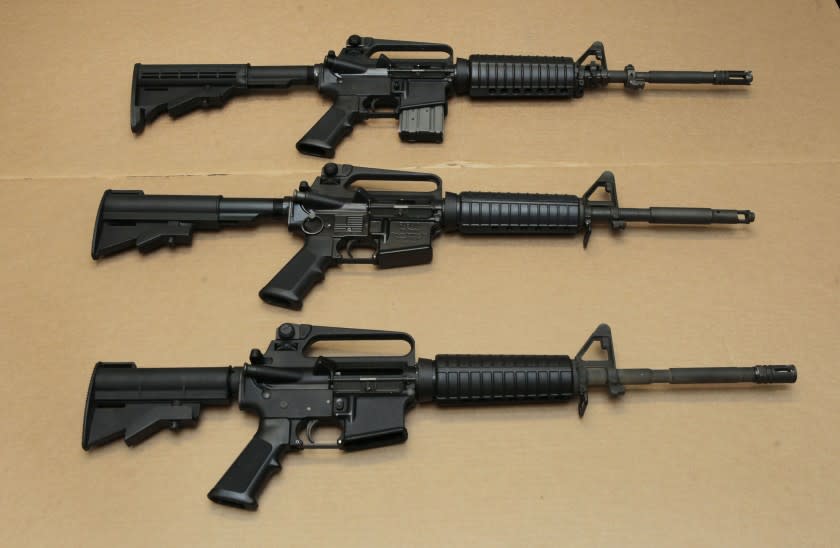Op-Ed: A nutty court ruling on California's assault weapons ban makes us less safe

- Oops!Something went wrong.Please try again later.
- Oops!Something went wrong.Please try again later.
Would anyone really compare an AR-15 assault rifle, which has been used in so many recent mass killings, to a Swiss Army knife?
Such a comparison is ludicrous, yet that is exactly what a federal judge in San Diego did on Friday in striking down California’s 32-year-old ban on assault weapons. Judge Roger Benitez began his decision by declaring, “Like the Swiss Army Knife, the popular AR-15 rifle is a perfect combination of home defense weapon and homeland defense equipment.”
This is the most extreme gun rights ruling yet from a federal court. Every other court in the country has upheld bans on assault weapons. This ruling is wrong as a matter of constitutional law and of common sense. Unfortunately, though, a majority of the current Supreme Court justices are very likely inclined to expand gun rights. But I hope they will not go so far as to declare that the Constitution protects a right to have an assault weapon.
The 2nd Amendment says: “A well regulated Militia, being necessary to the security of a free State, the right of the people to keep and bear Arms, shall not be infringed.” From 1791, when it was ratified, until 2008, not one law — local, state, or federal — was struck down as violating the 2nd Amendment.
When dealing with 2nd Amendment cases, the Supreme Court has repeatedly said that the provision meant what it said: It was solely a right to have guns for the purpose of militia service.
In June 2008, the court, in a 5-4 decision in District of Columbia vs. Heller, took a very different approach and said that the 2nd Amendment protected a right of people to have guns in their homes for the sake of security.
Justice Antonin Scalia wrote the opinion for the court and declared unconstitutional a 1976 ordinance in Washington that prohibited private ownership or possession of handguns. But the court was clear that this right is not absolute and the government can regulate who has guns, where they have them and what type of weapons are allowed.
In fact, Justice Scalia’s opinion stated that the right to possess arms was limited to weapons that “were in common use at the time” the 2nd Amendment was ratified. He said this “limitation is fairly supported by the historical tradition of prohibiting the carrying of ‘dangerous and unusual weapons.’”
No one can argue that AR-15 style weapons existed, let alone were in common use, in 1791. Nor can it be denied that they are very dangerous weapons. This type of semi-automatic weapon has been used in many of the worst mass shootings in the United States, including the 2012 Sandy Hook Elementary School shooting, the 2015 San Bernardino attack, the 2017 Las Vegas shooting, the 2017 Sutherland Springs church shooting, the 2018 Stoneman Douglas High School shooting and the shooting at a Colorado grocery store in March that killed 10 people.
Judge Benitez argued that the 2nd Amendment protects a “muscular” constitutional right and the California ban is “about average guns used in average ways for average purposes.” He added, “In California, murder by knife occurs seven times more often than murder by rifle.”
This attempt to minimize the danger of assault weapons fails to recognize that they are banned by California and other states (and for a time by the federal government) because of their ability to kill a large number of people in a short amount of time.
Judge Benitez described California’s law as a “failed experiment” because there have been mass killings with assault weapons since its enactment in 1989. But by that analysis, every criminal law would be a failed experiment because they are repeatedly violated. This argument makes no sense because there is no way to know how many more mass shootings would have occurred without California’s ban.
Clearly, the United States Court of Appeals for the 9th Circuit should reverse this ruling and allow the assault weapons ban to stand. Eleven judges on the 9th Circuit will soon hear another decision by Judge Benitez striking down California’s ban on large-capacity ammunition magazines.
I fear the conservative majority on the Supreme Court will soon go much further in expanding gun rights. Justices Clarence Thomas and Samuel Alito already have urged this. The three newest justices — Neil Gorsuch, Brett M. Kavanaugh and Amy Coney Barrett — are also seen as likely to expand 2nd Amendment rights. This fall, the court will hear a case challenging a New York law limiting carrying of concealed weapons.
Still, even a Supreme Court that expands gun rights is likely to impose some limits. No right in the Constitution is absolute. And these limits must include the ability of states to outlaw weapons of mass murder, like assault rifles. A Swiss Army knife might be used to stab one person, but an AR-15 can be used to kill dozens of people in the same amount of time.
Erwin Chemerinsky is dean of the UC Berkeley School of Law and a contributing writer to Opinion. He is the author of a forthcoming book, “Presumed Guilty: How the Supreme Court Empowered the Police and Subverted Civil Rights.”
This story originally appeared in Los Angeles Times.

